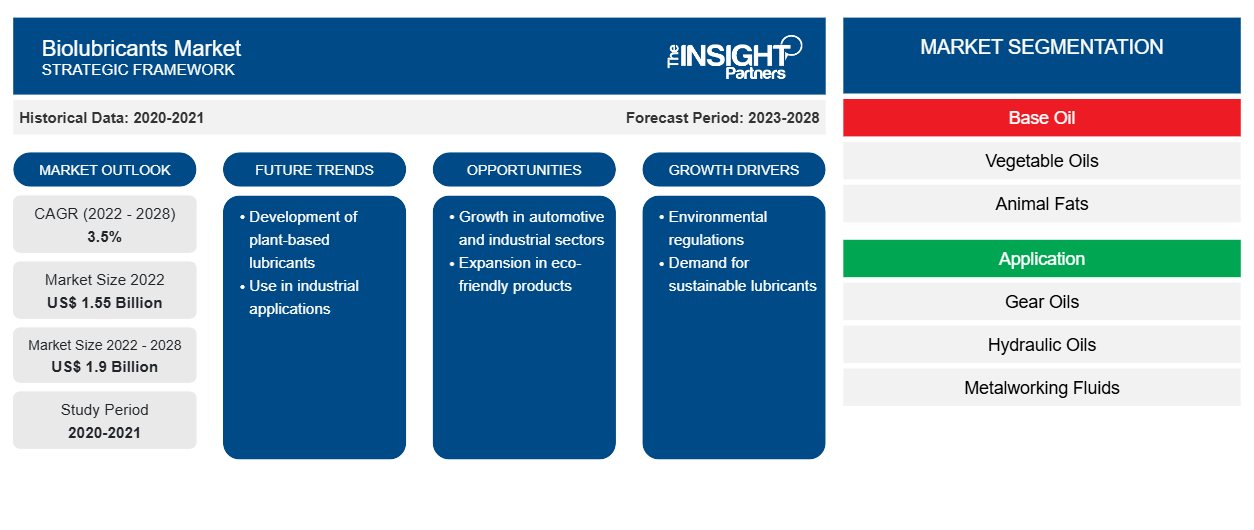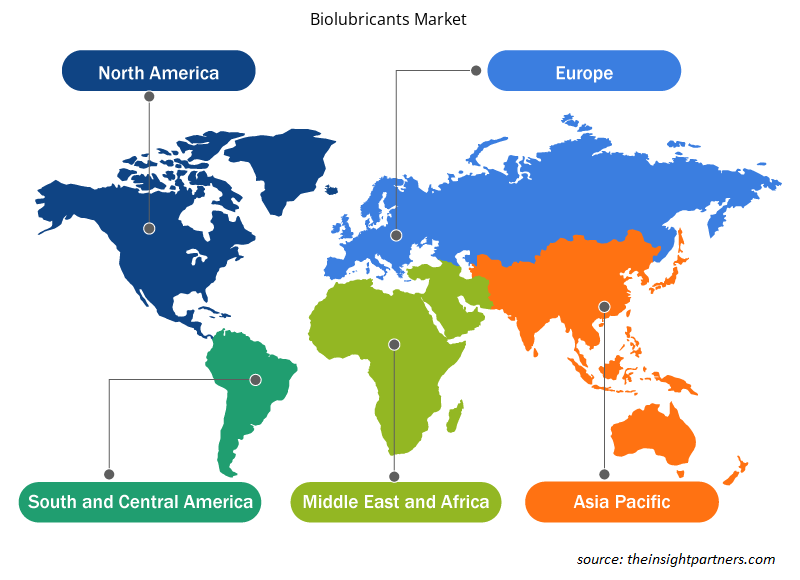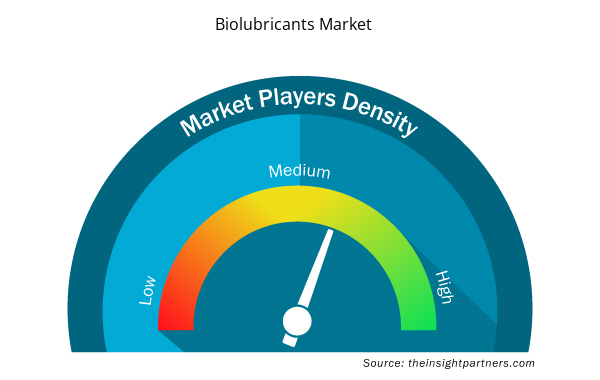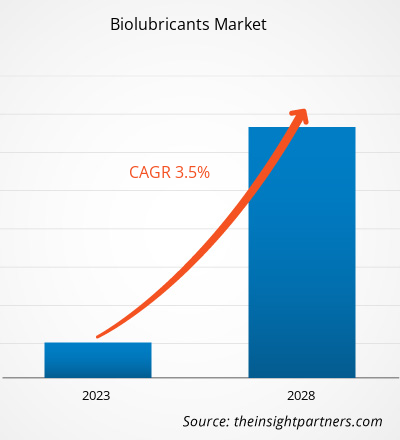The biolubricants market is expected to grow from US$ 1,551.15 million in 2022 to US$ 1,902.41 million by 2028; it is estimated to record a CAGR of 3.5% from 2022 to 2028.
Biolubricants are made from oils derived from vegetables and other renewable resources, including animal products. Biolubricants are biodegradable and nontoxic for humans and aquatic environments. Biodegradability of biolubricants plays a vital role in applications which have a high risk of leaking into the environment. In addition, biolubricants have higher flash points, constant viscosity, and less oil mist/vapor emissions and offer increased safety. Biolubricants also produce fewer emissions and have superior adhesion to metal surfaces. They are used in various applications, including engines, gearboxes, hydraulics, chainsaws, greases, and 2-stroke speedboat engines. Biolubricants are highly used in various end-use industries such as automotive, marine, agriculture & forestry, mining, construction, power transmission, food, and pharmaceuticals.
The biolubricants market growth is attributed to the growing demand for biolubricants from various end-use industries due to increased environmental consciousness, strict environmental laws mandating the use of environmentally acceptable lubricants, and the high disposal expense of the existing non-degradable lubricants. In many countries, there are regulations that forbid the use of mineral oil-based lubricants around inland waterways. Such regulations are driving the demand for biolubricants for various applications. Further, since biolubricants are clean and nontoxic, their use has been mandated in highly sensitive applications such as forestry and marine in some countries across the world. In marine applications, biolubricants are used in different sections and processes of containers, cargo fleets, oil tankers, and other ships for lubrication purposes. Marine biolubricants consist of engine oils, hydraulic oils, compressor oils, slideways oils, gear oils, heat transfer oils, greases, turbine oils, and others. Further, the global seaborne international trade growth has propelled the demand for biolubricants, as they have high efficiency and low emission capacity. Thus, increased use of biolubricants from the marine industry will offer lucrative opportunities for the biolubricants market during the forecast period.
Customize This Report To Suit Your Requirement
You will get customization on any report - free of charge - including parts of this report, or country-level analysis, Excel Data pack, as well as avail great offers and discounts for start-ups & universities
Biolubricants Market: Strategic Insights

- Get Top Key Market Trends of this report.This FREE sample will include data analysis, ranging from market trends to estimates and forecasts.
Customize This Report To Suit Your Requirement
You will get customization on any report - free of charge - including parts of this report, or country-level analysis, Excel Data pack, as well as avail great offers and discounts for start-ups & universities
Biolubricants Market: Strategic Insights

- Get Top Key Market Trends of this report.This FREE sample will include data analysis, ranging from market trends to estimates and forecasts.
Market Insights
Increasing Demand from Automotive Industry Drives Biolubricants Market Growth
Engine oils, transmission fluids, gearbox oils, brake and hydraulic fluids, and other automotive oils are used in the automobile & transportation industry. Biolubricants are used as antifriction and heat-absorbing media and lead to smooth and reliable functions/operations, reducing the risks of frequent failures that help enhance the durability/life-cycle of the vehicle. Automotive lubricants are utilized to reduce friction and moderate the heat produced when two surfaces are in mutual contact. Furthermore, bio-based engine oils display a higher inherent biodegradation rate, low toxicity to aquatic organisms, and very low levels of bioaccumulation. Further, replacing hydrocarbon-based oils with biodegradable products is one of the ways to reduce the adverse effects of lubricants on the ecosystem. With increasing regulatory pressure on improving the fuel efficiency of vehicles and reducing emissions of greenhouse gases, there has been a remarkable development in oil lubricant formulations. These factors are boosting the demand for biolubricants in the automotive industry.
Base Oil Insights
Based on base oil, the biolubricants market is segmented into vegetable oils, animal fats, and others. The vegetable oils segment held the largest share of the market in 2022. Vegetable oils are preferred alternatives to mineral oils for lubricant base stocks because of certain inherent properties, including high viscosity, high boiling range, and biodegradability. Fatty acids in the oil can be chemically modified to form high molecular weight esters, which can substitute conventional mineral oil-based lubricants. These factors are expected to drive the growth of the market for the vegetable oils segment.
Emery Oleochemicals LLC, Fuchs Petrolub SE, Carl Bechem GmbH, PANOLIN AG, Renewable Lubricants Inc, TotalEnergies SE, Shell Plc, RSC Bio Solutions LLC, Crevier Group Inc, and Kluber Lubrication GmbH & Co KG are among the key players operating in the biolubricants market. The leading players adopt strategies such as mergers and acquisitions and product launches to expand their geographic presence and consumer base.
Biolubricants Market Regional Insights
Biolubricants Market Regional Insights
The regional trends and factors influencing the Biolubricants Market throughout the forecast period have been thoroughly explained by the analysts at Insight Partners. This section also discusses Biolubricants Market segments and geography across North America, Europe, Asia Pacific, Middle East and Africa, and South and Central America.

- Get the Regional Specific Data for Biolubricants Market
Biolubricants Market Report Scope
| Report Attribute | Details |
|---|---|
| Market size in 2022 | US$ 1.55 Billion |
| Market Size by 2028 | US$ 1.9 Billion |
| Global CAGR (2022 - 2028) | 3.5% |
| Historical Data | 2020-2021 |
| Forecast period | 2023-2028 |
| Segments Covered |
By Base Oil
|
| Regions and Countries Covered | North America
|
| Market leaders and key company profiles |
Biolubricants Market Players Density: Understanding Its Impact on Business Dynamics
The Biolubricants Market market is growing rapidly, driven by increasing end-user demand due to factors such as evolving consumer preferences, technological advancements, and greater awareness of the product's benefits. As demand rises, businesses are expanding their offerings, innovating to meet consumer needs, and capitalizing on emerging trends, which further fuels market growth.
Market players density refers to the distribution of firms or companies operating within a particular market or industry. It indicates how many competitors (market players) are present in a given market space relative to its size or total market value.
Major Companies operating in the Biolubricants Market are:
- Emery Oleochemicals LLC
- Fuchs Petrolub SE
- Carl Bechem GmbH
- PANOLIN AG
- Renewable Lubricants Inc
Disclaimer: The companies listed above are not ranked in any particular order.

- Get the Biolubricants Market top key players overview
Report Spotlights
- Progressive trends in the biolubricants industry to help players develop effective long-term strategies
- Business growth strategies adopted by companies to secure growth in developed and developing markets
- Quantitative analysis of the global biolubricants market from 2020 to 2028
- Estimation of the demand for biolubricants across various industries
- Porter's Five Forces analysis to illustrate the efficacy of buyers and suppliers operating in the biolubricants industry
- Recent developments to understand the competitive market scenario and demand for biolubricants
- Market trends and outlook, and factors governing the growth of the biolubricants market
- Enlightening strategies that underpin commercial interest concerning the market growth, aiding in the decision-making process
- Biolubricants market size at various nodes of market
- Detailed overview and segmentation of the market, as well as its industry dynamics
- Biolubricants market size in various regions with promising growth opportunities
The "Biolubricants Market Forecast to 2028" is a specialized and in-depth study of the chemicals & materials industry, focusing on the biolubricants market trend analysis. The report aims to provide an overview of the market with detailed segmentation. The biolubricants market is segmented on the basis of base oil, application, end use, and geography. Based on base oil, the market is segmented into vegetable oils, animal fats, and others. Based on application, the market is segmented into gear oils, hydraulic oils, metalworking fluids, greases, and others. By end use, the biolubricants market is segmented into automotive, industrial, marine, agriculture & forestry, and others. The market is segmented into five main regions North America, Europe, Asia Pacific, the Middle East & Africa, and South & Central America. In 2022, Europe dominated the biolubricants market. Asia Pacific is expected to register the highest CAGR in the market during the forecast period. Factors such as growing environmental concerns and increasing crude oil costs are driving the demand for biolubricants in Europe. The demand for biolubricants in Asia Pacific is directly proportional to industrialization and vehicular production in the region. Growing regional construction activities and industrial and automotive sectors accelerate the market growth.
- Historical Analysis (2 Years), Base Year, Forecast (7 Years) with CAGR
- PEST and SWOT Analysis
- Market Size Value / Volume - Global, Regional, Country
- Industry and Competitive Landscape
- Excel Dataset


- UV Curing System Market
- Lymphedema Treatment Market
- 3D Mapping and Modelling Market
- Latent TB Detection Market
- Transdermal Drug Delivery System Market
- Quantitative Structure-Activity Relationship (QSAR) Market
- Queue Management System Market
- Procedure Trays Market
- Advanced Planning and Scheduling Software Market
- Parking Management Market

Report Coverage
Revenue forecast, Company Analysis, Industry landscape, Growth factors, and Trends

Segment Covered
Base Oil, Application, and End Use

Regional Scope
North America, Europe, Asia Pacific, Middle East & Africa, South & Central America

Country Scope
Argentina, Australia, Brazil, Canada, China, France, Germany, India, Italy, Japan, Mexico, Russian Federation, Saudi Arabia, South Africa, South Korea, United Arab Emirates, United Kingdom, United States
Frequently Asked Questions
The major driver for the growth of the biolubricants market is the growing demand for biolubricants from various end-use industries due to increased environmental consciousness, strict environmental laws mandating the use of environmentally acceptable lubricants, and the high disposal expense of the existing non-degradable lubricants. In many countries, there are regulations that forbid the use of mineral oil-based lubricants around inland waterways. Such regulations are driving the demand for biolubricants for various applications. These factors are driving the biolubricants market growth.
During the forecast period, marine is expected to be the fastest-growing segment. Biolubricants significantly improve machine performance, minimize environmental impact, and are safe and convenient for marine applications. Synthetic lubricants lost from marine vessels and machinery (not accidental spills) enter the aquatic ecosystem, where severe damage could take place. Hence the usage of ecosystem-friendly and biodegradable marine lubricants is on the rise. In addition, stringent regulations imposed by various governments are encouraging the application of biolubricants in the marine industry. These factors are expected to boost the growth of the marine segment in the biolubricants market demand during the forecast period.
During the forecast period, the hydraulic oils segment is expected to be the fastest-growing segment. Bio-based hydraulic oils inherently have a high viscosity index, which cuts the cost of additional viscosity improvers. Biodegradable fluids are increasingly used in hydraulic equipment, especially in sensitive environments such as food processing plants, water/wastewater, and pharmaceutical processing. These factors are expected to accelerate the growth of the hydraulic oils segment of the biolubricants market.
In 2022, the vegetable oil segment held the largest market share. Vegetable oils are preferred alternatives to mineral oils for lubricant base stocks because of certain inherent properties, including high viscosity, high boiling range and biodegradability. Fatty acids present in the oil can be chemically modified to form high molecular weight esters, which can substitute conventional mineral oil-based lubricants. These factors led to the dominance of the vegetable oils segment in 2021.
Some of the major players operating in the biolubricants market are Emery Oleochemicals LLC, Fuchs Petrolub SE, Carl Bechem GmbH, PANOLIN AG, Renewable Lubricants Inc, TotalEnergies SE, Shell Plc, RSC Bio Solutions LLC, Crevier Group Inc, and Kluber Lubrication GmbH & Co KG.
In 2022, Europe accounted for the largest share of the global biolubricants market. Various regulations imposed by the European Union have encouraged the consumption of biolubricants due to their environment-friendly properties. The factors such as growing environmental concerns, an increase in the cost of crude oil, and the growing automotive industry of the region led to the dominance of Europe in 2021.
Trends and growth analysis reports related to Chemicals and Materials : READ MORE..
The List of Companies - Biolubricants Market
- Emery Oleochemicals LLC
- Fuchs Petrolub SE
- Carl Bechem GmbH
- PANOLIN AG
- Renewable Lubricants Inc
- TotalEnergies SE
- Shell Plc
- RSC Bio Solutions LLC
- Crevier Group Inc
- Kluber Lubrication GmbH & Co KG

 Get Free Sample For
Get Free Sample For